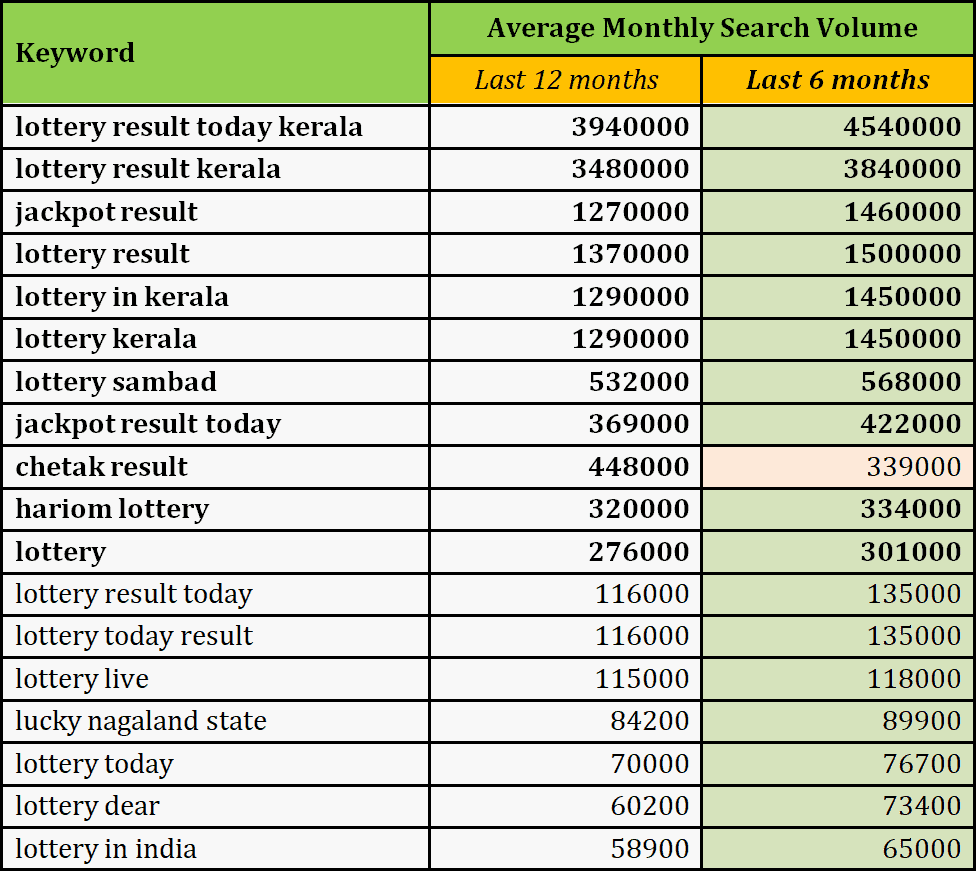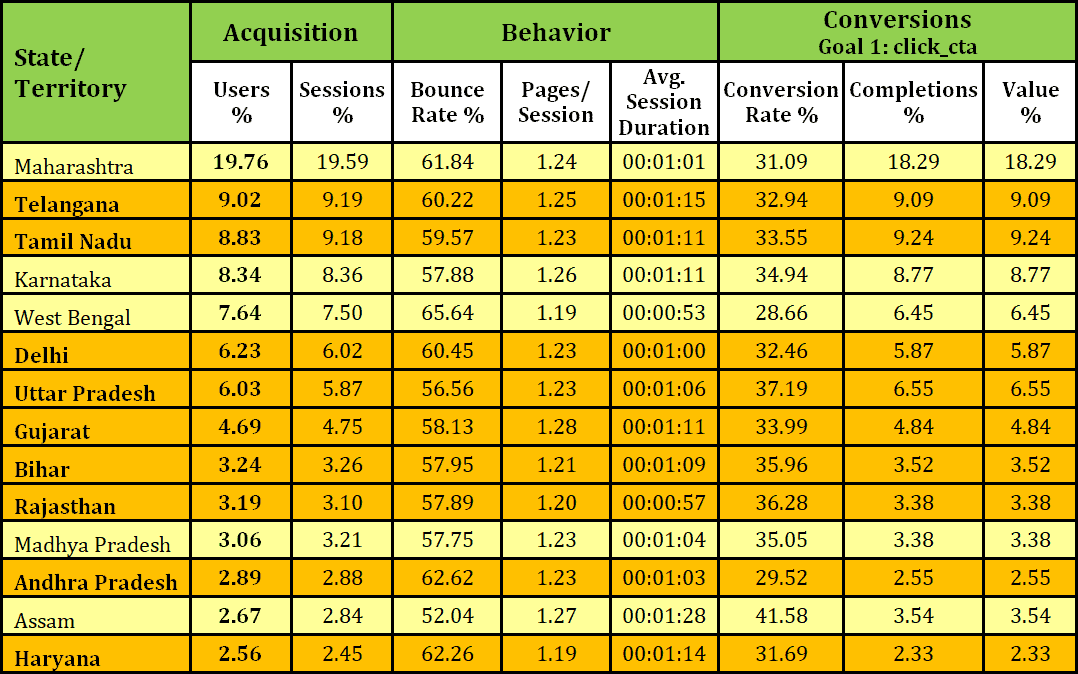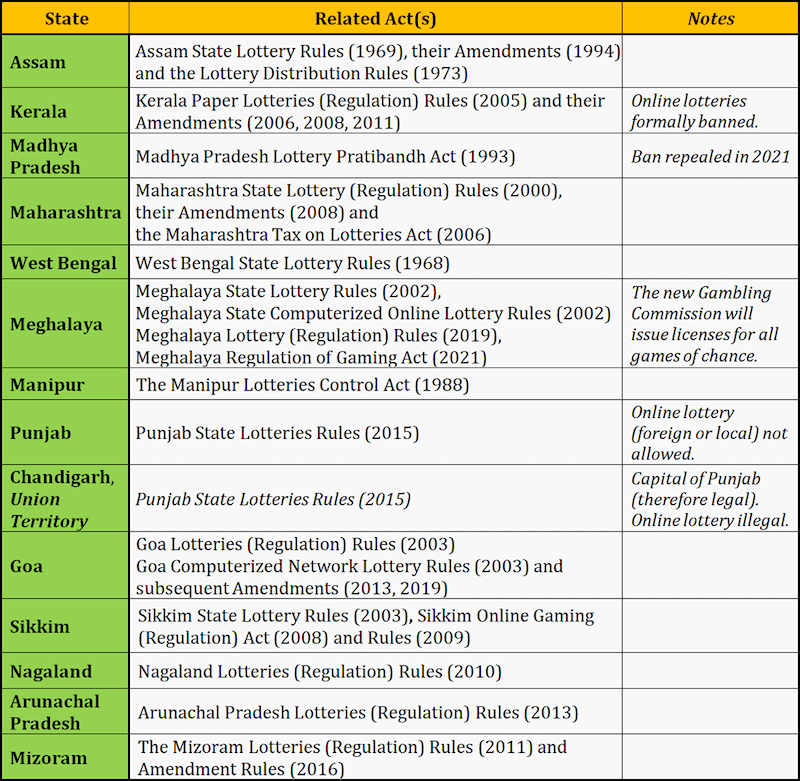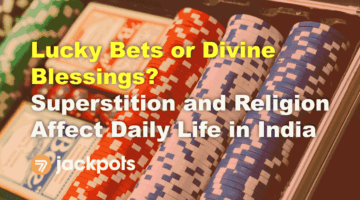Who Plays Online Lottery in India?
The nature of our study on Indian online gambling allows us to put the spotlight on important market insights such as the demographics of Indian lottery players. SevenJackpots aggregated traffic data shows that, on average, these are young males living in a big city. Recent scientific research confirms this observation, citing married men around 30 (with a kid or two, renting rather than owning) as the typical lottery player. Read more about Understanding Indian Lotteries Trends Across India.
Lottery is the most common gambling product in all Indian states where it took root a long time ago – e.g., Goa, Kerala. This is not surprising, as it is also the case in many developed gaming markets like the US and the UK. In fact, up to two-thirds of gamblers engage in lottery, choosing it over casino or other betting options. With age, most become even more “loyal” to it.
State Origin
SevenJackpots user sessions over eight months have also been broken down into State origin, along with traditional industry indicators like acquisition, behaviour, and conversion statistics. The latter gives a better idea about user experience (UX), something we already amply covered in our performance comparison research.
As established earlier by our team, Maharashtra is always a market to be reckoned with in online gambling – nearly 20% of the online lottery traffic comes from there. The same social and economic factors explain why the leading states are largely the same, typically including Telangana (9.02% of online lottery users), Tamil Nadu (8.83%), Karnataka (8.34%), West Bengal (7.64%) and the National Capital Territory of Delhi (6.23%). Moreover, these contain seven of the eight Tier-1 cities – Mumbai, Pune, Kolkata, Bengaluru, Hyderabad, Chennai, and Delhi.
However, the most important aspect that stands out is that almost every state with significant player traffic does not have a local paper-ticket lottery, apart from Maharashtra and West Bengal. (Karnataka has never outlawed it either). States without a government-run lotto scheme dominate the Top 15 list and take up around 56% of the overall user volumes for the site.
In other words, these large areas of India that are left without a local legal lottery are likely to seek alternatives, whether online or on the black market.
Demographics Explained
- The most relevant age group is 25-34, accounting for 31.44% of all users;
- Under-34, altogether, add up to a whopping 56.4%;
- Males (79.24%) dominate the scene.
The youngest adults (18-24) make up a quarter of registered users (24.96%) and are the second most important age cohort. While these figures are valid specifically for online lottery players. Not regular paper lottery, the above scientific references confirm that both kinds are not far off each other.
As far as social status and lifestyles are concerned, paper-based government lotteries are typically considered more suitable for players with limited access to technology. Despite boasting over 800 million online users, this still leaves about half of India’s adult population in that disadvantaged group. With less disposable income, this user pool is served by street vendors and state lotteries as cheap as Rs 5-6 per ticket (never below Rs 2, as per the 1998 Lottery Act).
Lifestyles
Online lotteries today appeal to players with a busy lifestyle and a mobile-first daily routine. Such distribution channels may end up being more costly while at the same time making the jackpots more consistent.
Governments have various strategies for reaching player markets. Kerala, the state with the most successful Lottery, advertises heavily in broadcast and print media, and slogans push the trustworthiness and transparency of the draw. This is also the state with the highest life expectancy and literacy rates of all the Union. Apparently, for this kind of player the above qualities count more than the low ticket price or the highest jackpot.
Goa, the state with the highest per capita State Domestic Product (~$6200), has a long-standing gambling tradition. It also reports some of the highest adoption rates for lottery – 67.8% of all gamers or a full third of Goan adults. Even more sizeable and better-developed markets – even the United States – see half of their adults (49%) buy lottery tickets.
Moreover, those who play the lottery often engage only in this type of gambling, preferring it over online casino or sports betting.
Devices Used
Last year’s lottery traffic on SevenJackpots also confirms the general dominance of mobile devices. Players that use desktops tend to spend a somewhat longer time on our website (before deciding to play or moving on) and visit more pages per session. However, higher conversion rates, registrations, and actual monetary transactions all prove the leading role of smartphones in accessing online lottery.
The Scope of India’s Offline and Online Lotteries
The inability (or unwillingness) of State governments to digitise their lotteries makes them hard to monitor and assess for most market analysts. Industry estimates (pre-GST introduction) quote Rs 50,000 crore annually. On the other hand, Post-GST sales are barely a third of that.
Organic traffic and search volumes show that online lottery is still small compared to its offline counterpart. However, it is also a much more quickly growing segment. Paper-based lotteries used to rely on a million retail points, but many have closed in post-Covid conditions. This leaves State finance departments with some tough decisions to make.
Understanding Indian Lotteries – Online Visibility of Lottery Demand
Combined lottery searches generate up to 30% of organic traffic on some of our sites. More specifically, during the first wave of lockdowns, users tended to turn to such familiar gaming genres. Scientific reports agree that in times of overall uncertainty, users revert to traditional consumption patterns – and there is nothing more traditional in Indian gaming than lotteries!

We explored the average monthly search volumes for the past 6 and 12 months to verify these trends. The top 10 terms that are closely related or instrumental to finding lottery products online add up to over 18 million monthly searches in the past year. More recently, over a semester, these are above 20 million (and more than 22 million, if we include wrongly or closely spelled words).
All but one (chetak) of these terms are growing in search volumes for the past six months compared to the previous time frame, following a stable trend. More importantly, in 2020, these search volumes were less than half their present size – at most, 8 million monthly lookups. Hence, we are talking about a growth in demand which has the potential to boost the online lottery market significantly, even in the short term.
Languages
And we also have to take into account the fact that local languages by State and ethnic groups are much more used in daily situations compared to English. KPMG studies claim that only around 12% of the population is familiar enough with English to use it “interchangeably.” Hindi has already overtaken English in the online dimension, while leading languages like Bengali, Tamil, Telugu, and Marathi account for another 30% of the online usage. For an estimated 70% of desi users, their native local language is more reliable than English.
Therefore, it is not a surprise that generic lottery terms still exceed explicit lookups of “online”, “mobile”, “app”, or other narrow definitions or technical searches. But this is not a point in favour of “paper” lotteries as they do not evoke a particular search interest either.
Although young generations originally joined the online market in their local language, they drive tech adoption in English as well. And the overall fragmentation of the Indian gaming market can only benefit from clearer and homogeneous standards. Online lottery retail and mobile distribution can easily provide that at intra-state and national levels.
Lotteries Are a State Business
Kerala was the first State to abolish private drawings and establish its legal lottery in 1967. Soon, others followed suit, and today 13 states allow or run official government lotteries:
Arunachal Pradesh, Assam, Goa, Kerala, Madhya Pradesh, Maharashtra, Manipur, Meghalaya, Mizoram, Nagaland, Punjab, Sikkim, and West Bengal.
Meghalaya is the latest addition to the list (2019), while the Union Territory of Chandigarh also allows the State Lottery of Punjab, being a joint capital of the same State and Haryana.
Andhra Pradesh was at one point considering running its own legal lottery (and even having offshore casinos) in an attempt to boost its tourism industry and public finances. Yet, this has not been voted in by AP legislators so far.
The Centre has recognised the importance of India’s lottery traditions and gaming culture since the infamous Public Gaming Act (1867). States were allowed to bring under control Satta Matka games and rein in the influence of rogue Matka kings.
Regulations
Betting upon the government’s reputation, state lotteries were further given guidelines with the Lotteries (Regulation) Act of 1998. To this day, this law frames the Indian lottery market in terms of basic definitions, prize schemes, drawing frequencies, ticket sales, and promoters.
It also sets certain limits on destinations of proceeds and prohibition jurisdictions, which are especially relevant in disputes between States. Emblematic cases include Kerala and Nagaland challenging each other before the High Court and the Centre to resolve long-standing issues. In fact, inter-State ticket sales are typically discouraged and require a prior formal agreement by authorities on both sides.
States can also adopt additional regulations and licensing regimes which do not contravene the 1998 Act. They are also aided by the Lotteries (Regulation) Rules of 2010, which address a series of implementation aspects. The Information Technology Act of 2000 and its 2008 Amendment also deal with communication channels and IT features that impact online lotteries.
Crucially, the Central Government does not hold its own lottery or promote any of the existing schemes in particular. Claims to the contrary are false, although occasionally seen in advertisement messages. However, New Delhi can interfere with State policies if officials consider the national laws to be violated.
Understanding Indian Lotteries – Types of Available Lotteries
Most players in India are familiar with two types of lottery draws – regular (daily or weekly) and special Bumper draws. Ordinary draws come as often as several times per day, while Bumpers are rare, up to 6 times per year, marking holidays and occasions like Holi, Diwali, New Year, Summer, or Vishnu. Bumper draws come with higher ticket prices and much bigger jackpots.
But the main distinction remains between paper lotteries and actual online lotteries. The former are still relatively easy to spot at street stands or Kirana stores. But they don’t give access to international lottery draws.
On a global scale, lotteries hold more than 15% of the gaming market’s market shares. With more people staying home and businesses experiencing a massive digital transition, games have also moved online. There are more smartphone apps and mobile lottery versions than ever before.
In India’s case, we are talking about a cultural rather than a technological transition. The ease of purchasing an electronic copy of a lottery ticket online does not suffice. Resulting in desi players still searching for outdated concepts like Satta online. On the other hand, innovations in the sector include online tombola alternatives and cryptocurrency gambling platforms, even if some might remain niche markets.
Therefore, there is a general awareness and technological readiness to move past paper-based lottery ticket sales. Online distribution is clearly more efficient, and India has already shown astounding tech adoption rates in most consumer-related sectors.
GST and Other Retail Concerns
When the Government introduced the 28% GST in mid-2017, lottery operators in India had to make a decision – raise ticket prices or lower jackpots. Effectively passing the levy onto the players, one way or another. Real money prizes are the most attractive part of playing the lottery. So tickets became more expensive, giving rise to illegal lotteries around the nation.
Sales revenues shrunk from an estimated $6.7 billion to less than a third of that annually, also because of fierce online competition. Illegal lottery schemes also reportedly cover half of the market, if not more.
Combined with Covid-related distribution limitations, it was not surprising to see some of the big Indian lottery operators brought down. The Playwin brand, run by the Essel Group, is a notable casualty.
Revenue losses affected smaller states more heavily, representing a proportionally higher share of their public revenues. Sikkim, Goa, and Nagaland pushed for lower taxes, requesting 18% GST. However, the Supreme Court ruled that the lottery is a premium type of consumption that should attract the highest tax slab.
Monitoring and control challenges
Often, paper lottery operators’ challenges are more practical than legal. Monitoring and control challenges are easily illustrated by the schemes in West Bengal and Kerala. Both states allow only paper lotteries, but their tickets are regularly smuggled over to Karnataka, Andhra Pradesh, Tamil Nadu, Jharkhand, or Bihar – all States without a legal Government lottery.
These are merely some of the reasons why offline market leaders began to struggle in the past few years. Stockists (corporate intermediaries) like Mumbai-based Sugal & Damani or Singapore’s Singam began diversifying their channels while still lobbying for Government support.
Politically justified destination of proceeds towards welfare projects did not suffice. Initial attempts to develop mobile lottery apps (e.g., Lucky Khel) were also largely unsuccessful. At the same time, most international lottery operators managed to transition heavily (if not completely) toward online platforms.
Digital environments became decisive for business sustainability across the lottery segment. We expect the Indian states and companies that postpone dealing with the matter to struggle even more in the near future.
Understanding Indian Lotteries – Online Lottery Market Leaders
As things stand, Indian lottery operators – be they public or private – cannot compare to their offshore counterparts in terms of distribution efficiency, jackpot sizes, ease of use, or any other technical aspect.
In our dedicated section, we have in-depth reviews of the top-listed online lottery platforms that drive the global competition in the sector. Among those that offer their services on the Indian market, we see leaders like LottoSmile (covering at least 50 different lotteries from around the World), and Lottofy as the newest top-rated entry on the list. We cannot overlook giants like Lottoland.asia (with more than 30 lotteries offered) and other offshore competitors like MultiLotto and The Lotter.
On their platforms, desi players can purchase and receive digital copies of famous American, European, Asian, and Australian draws like MegaMillions, Powerball, EuroMillions, SuperEnalotto, EuroJackpot, El Gordo, and many others. Options include group purchases (syndicates) and personal bundles. Most operators also offer some basic lottery tips, odds, and strategy blogs.
Government Lotteries in India, State by State
It is easier for players who are physically present in states with legal government lotteries to follow the game firsthand. Each state has a separate policy, ticket prices, and drawing frequencies. Below is an overview of the current legal basis for their operation.
Some of the biggest and most important lottery draws across India include:
- Kerala as the largest public lotto scheme in the Union;
- the Nagaland lottery is another one with national relevance. The Dear Lottery brand is available in Sikkim and West Bengal, among other states;
- the Lottery Sambad brand, offering some of the cheapest lottery tickets in the Union, with vendors in all 13 states that allow lotteries.
Outside the “legal lottery states” list, Karnataka and Tamil Nadu previously also had successful lotteries schemes. Since then, they have banned the sale of lottery tickets altogether on their territory.
The Future of India’s Lottery Market
With stable demand and deep-rooted traditions, Bharati lotteries are an important economic sector currently dominated by public authorities. The digital transformation in the Union and the presence of some highly competitive offshore and mobile lottery operators are likely to shake up the market in the near future.
Scientists have proven the potential of lotteries to fuel optimism in times of crisis, outpacing other real-money gaming genres. In this context, digital channels can compensate and exceed slow sales in physical retail locations.
India’s fintech and digital sectors have shown their readiness for the mobile and online era. An organic growth in interest is likely to put further pressure on paper-ticket retailers and test the habits of the remaining lottery players that rely mostly on local sales points.
Despite sizeable revenues from tickets and tax proceeds, state governments have largely failed to invest in stable and innovative solutions for their legal lotteries.
Nevertheless, we expect the above-discussed trends to gradually lead the entire Indian lottery industry towards better performance levels and a new digital dimension.
To maintain their reputation and the high levels of associated trust, government-run lottery schemes must go online and do so swiftly. A transition to online sales will also provide them with better consumer safety standards, offer more payment and cash-out options and create job opportunities locally.
The alternative is not only losing out on these economic spillover effects. But would also mean handing over the entire market to offshore operators and black-market dealers.













